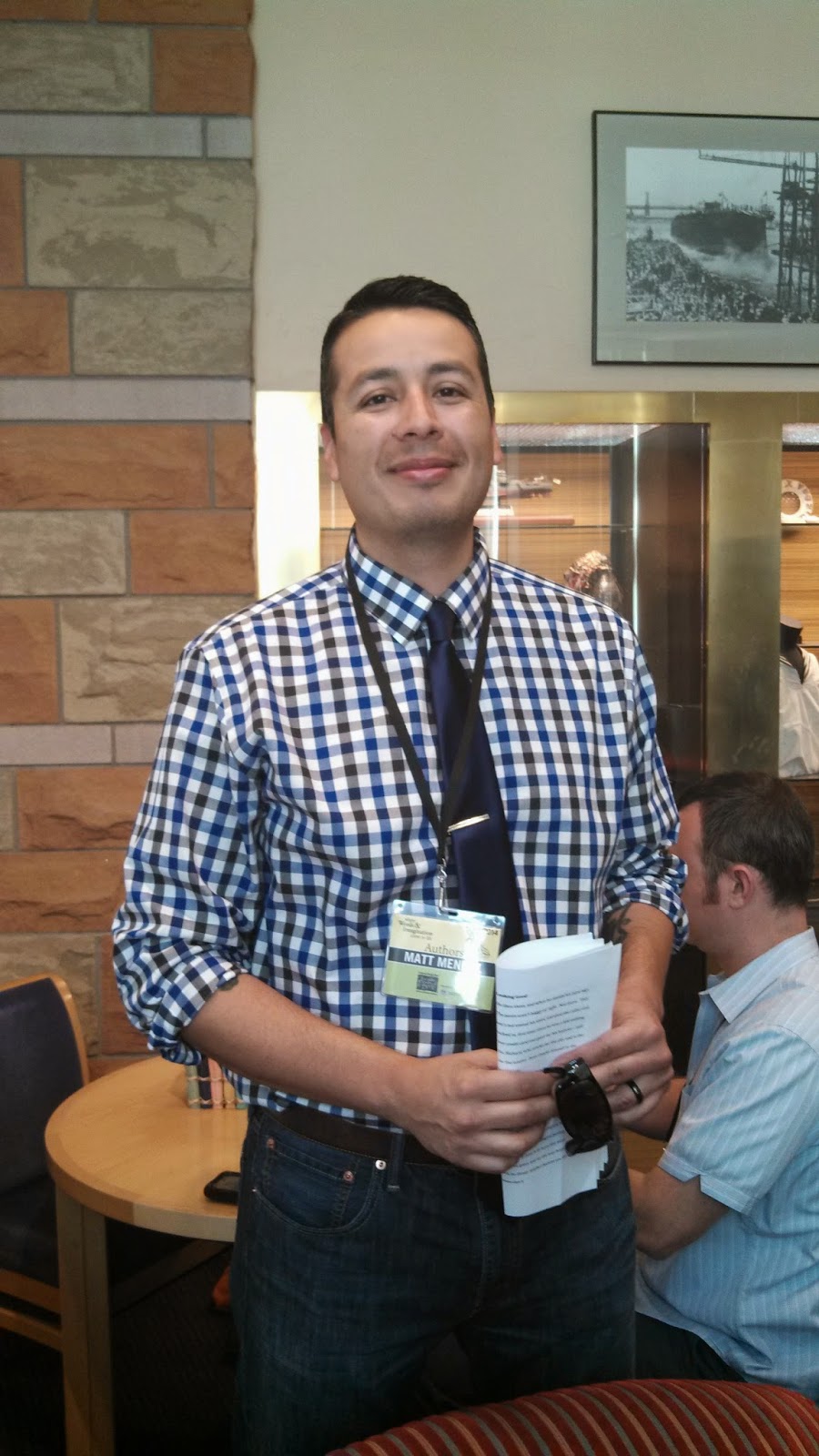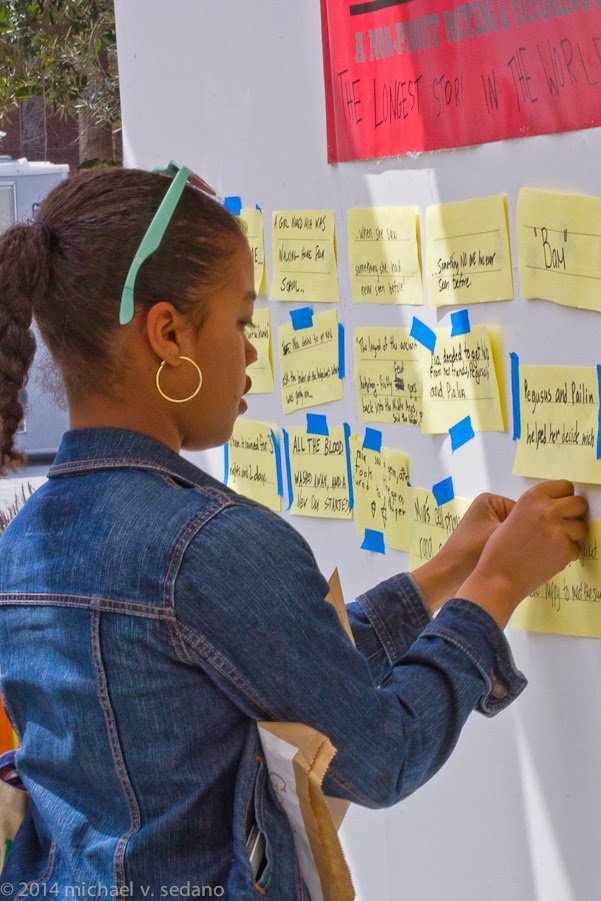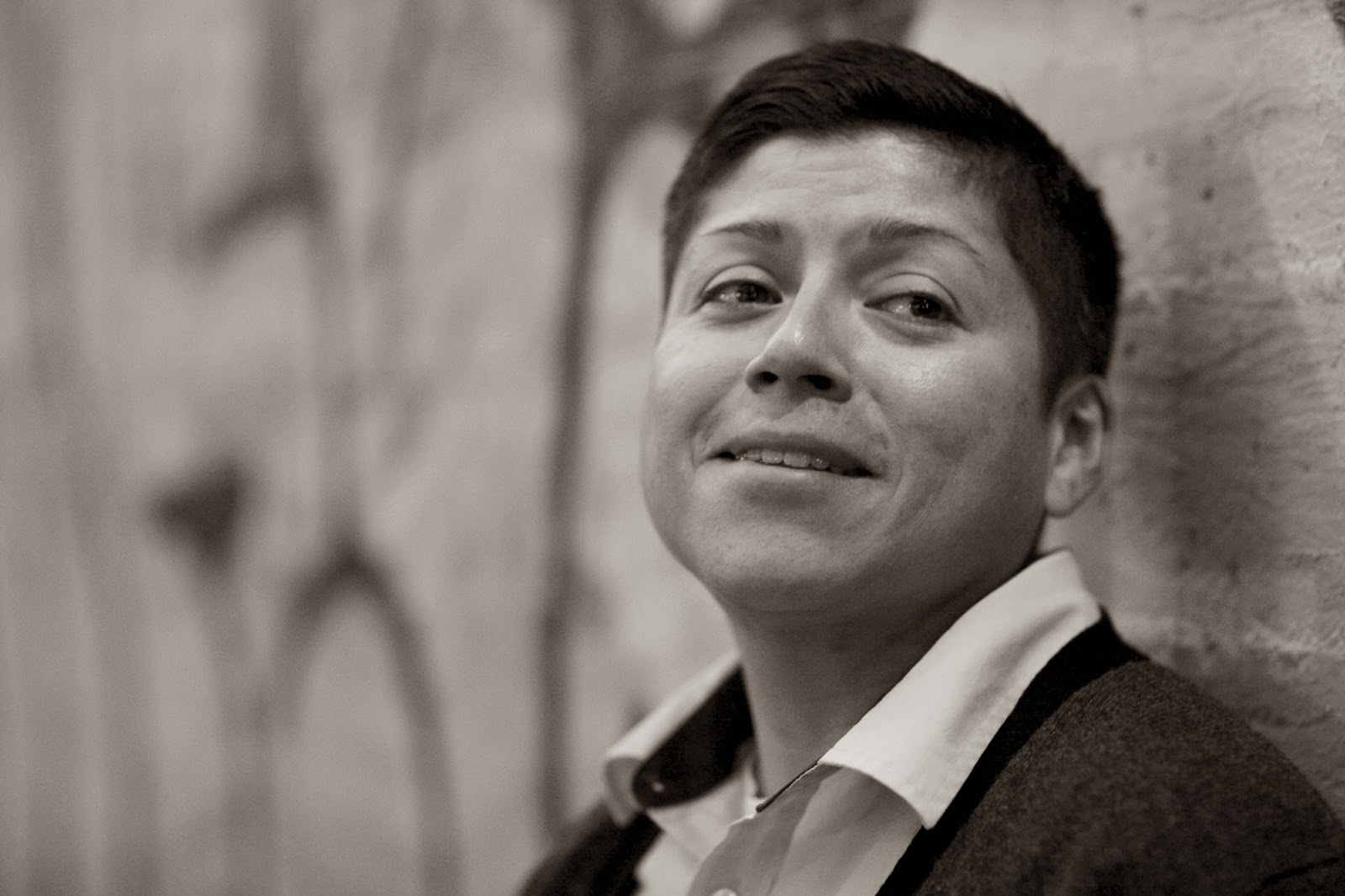Free Poetry on Bunker HillMichael Sedano
The land rises steeply up Los Angeles' Bunker Hill, a green space flanked by massive cement government buildings. The terrain makes it a walk of multiple stairs and gently sloping ramps to land on wide paved terraces and sprawling lawns. Landscaping, and the gente at today’s Grand Park Downtown Bookfest, keep my attention on the ground, then I look up. All I could see from where I stood was the Music Center at the top of the hill. I turned and looked the other way and saw City Hall tower. Then I go in search of free poetry.
Grand Park Downtown Bookfest signals Los Angeles’ ongoing support for literacy—there are never too many bookfests--and the region’s renascence of poetry as a public activity. Today, poets will both read and compose on-the-spot poems; for free, just stop and chat.
Bookfest organizer
Writ Large Press occupies a large space where books and authors invite passersby into the display. Next door is a tent where anyone can type a story on a real typewriter and publish it into their own book. I watch amused as a teenager types a line then looks up wondering how to get to a new line. “I don’t know how it works.”
Saturday’s quest begins Thursday afternoon in Highland Park, at Avenue 50 Studio where Jessica Ceballos, Los Angeles’ indefatigable poetry promoter via
Poesía Para La Gente, assembles a sign-making crew.
Starting with the rawest materials, Scott Doyle, Naomi Molinar and Lucy Delgado craft “Free Poetry” and “Poema Gratis” signage for Saturday’s event.
Saturday, I spot Doyle working 826LA’s display, urging passersby to contribute to the world’s longest story. Write, post, join in. It’s the best kind of yellow journalism from the grass roots.
826LA makes effective use of its prime location to draw people to stop for long periods, to read the world’s longest story, to ask a question of the writing and tutoring center’s volunteers.
Visit 826LA’s website to learn its mission “supporting students ages 6 to 18 with their creative and expository writing skills, and to helping teachers inspire their students to write.”
Red Hen Press has another prime spot, a pair of eight foot tables at a main intersection. Billy Goldstein answers questions while author Nicelle Davis dresses like a cloud as a marketing gimmick for her book,
Becoming Judas.The Shakespeare Center Los Angeles tent occupies the corner diagonally from Red Hen. Marina Oliva explains her mission includes producing full-length plays. Assisted today by Giovanni and Noemi, they were giving away editions of Richard II. Marina explains the play is not on the bill this summer, Romeo and Juliet and Midsummer Night’s Dream are ideas. Shakespeare Center supports Veterans and proposes an interesting
drama program for returning Veterans here. Ceballos introduces me to Victor Robert, whose wordless book encourages a kid’s storytelling unconstrained by what words the author might put on the page, or a writer’s frustration at all the words not used instead. You can learn more about the book, Brian Wonders, at the
author’s website here.
I introduce myself to Roxy Morataya, who occupies a table at the ‘Zines tent. I used to think ‘Zines an internet phenomenon that got supplanted by the blog. It’s a treat seeing contemporary ‘Zines. Exhibitors have covered two eight foot tables with ‘Zines. A 3-skein clothesline sways and frees some exemplars to a whirling wind that catches printed documents in a climatologic metaphor for literary ephemera.
‘Zines, like other literary ephemera, come in various forms, from multi-page saddle-stitch chapbooks to documents committed to a single sheet. Roxy traded me two quarters for an accordion-folded eight page handmade book she makes from a single sheet of typing paper.
Entertainment for the familia means kids’ entertainment. My eye is attracted by the plastic shakers I spy with my little eye on a table near the stage where
Story Pirates keeps kids engaged and attentive. Sadly, I’ve missed Birdie’s performance, the ebullient woman at the table tells me. On video, I catch up with Birdie’s Playhouse
on Birdie’s website.
I catch up with the free poetry signs along the grassy knoll overlooking the stage, and the picnic lawn sloping down to the stage esplanade. Poets to the left of me, poets to the right. I see Karineh Madhessian emcee of La Palabra Reading Series, and Victor Avila, a regular On-line Floricanto contributor, greeting visitors.
I spot Brandon Brown and a beaming Lucy Delgado with her poem on a vinyl album.
![]()
Visitors are delighted to talk to real poets and take in the sight of so many in one place. Poets create on typewriters, with Sharpie pen on vinyl 33 1/3 rpm records, stuff handwritten cards in rubber gloves, find poetry on random pages of pulp novel, send along a linocut postcard with a poem.
Dane F. Baylis chooses flip chart paper and chalk crayon that needs a spritz of fixative before the poet scrolls the poem for visitors like the delighted Sofia.
Grand Park Downtown Bookfest makes a friendly warm-up for the upcoming gargantuan LA
Times book festival that sprawls across the nearby USC campus. The only dour note are the white-shirted County cops. All whom I ask if they’d like a poem erect a wall of hostility. An LAPD cop is an exception, laughing with me that maybe later.
Other than those sour deputies, this year’s Writ Large Press and Jessica Ceballos and crew do everything possible to have a completely enjoyable show. As word of mouth spreads, I foresee visitors to next year’s Grand Park Downtown Bookfest looking forward to another comfortable and free-spirited afternoon with books and poetry.
Print Start-upArt! The Magazine In New Edition
Print continues to challenge the marketing efforts of anyone with the ganas to launch a print product.
Art! The Magazine this month reaches a milestone fourth issue.
Printed on coated paper in rich colors, the visual quality alone of
Art! The Magazine makes every issue a collector's item. Text content adds richness to the already dazzling graphics and layout. The current issue's story on muralist David Botello comes with luxurious close-ups. The cover story on how gente are updating the calavera look is a timeless addition to DDLM lore.
Underpriced at $6.95, the magazine has yet to hit its advertising stride. That makes each issue content-rich, but limits the ability of the publisher to reach for ever more ambitious editorial content and more pages.
Click here for availability and access.Print Media ReportBrooklyn & Boyle Hitting It BiggerA successful commercial print publication needs a fifty percent ad hole to begin to meet publisher needs and goals. Getting there offers immense challenges to any print publication.
Brooklyn & Boyle's current edition comes with a satisfying ad volume. That's encouraging to anyone who roots for community media.
With continued ad expansion, Editor-Publisher and La Bloga friend Abel Salas may have built the momentum with advertisers to expand
Brooklyn & Boyle circulation and coverage. It's already a highly admired community resource with a high pass-along endorsement. People talk about what they read in
Brooklyn & Boyle.Other weeklies still hold the lion's share of SoCal advertiser dollars, but they're missing the boat. Like
Art! The Magazine, Brooklyn & Boyle's readers tend to be community opinion leaders. Advertisers and marketers wisely value word of mouth because a friend's recommendation is among the more powerful motivators. Word of mouth begins with opinion leaders, Brooklyn & Boyle readers.
For gente outside Brooklyn & Boyle's circulation area, the website doesn't hide behind a paywall.
Click here to visit.
On-Line Floricanto First of April 2013Paul Aponte, Tara Evonne Trudell, Betty Sánchez, Joe Navarro, Ramón Piñero
"Grand Canyon State" by Paul Aponte
"Crossing…" by Tara Evonne Trudell
"Bracero" por Betty Sánchez
"I Understand Peace, Equality, Justice and Hope" by Joe Navarro
"i had a gun" by Ramón Piñero
GRAND CANYON STATE by Paul AponteThe Grand Canyon:
Majestic, riveting walls of time
Encrusted with history and life
Encrusted with aromas of water trickling on stone
& clean, fresh, crisp air.
Encrusted with colors & beauty of the cactus flowers,
wood betonies & red monkey flowers,
songs of Warblers & Western Bluebirds.
Encircled by morphic skies
watching over the flight of Falcons and Condors.
Rushing white waters like our bustling cities,
gentle trickles like restful small towns that care,
flowing strong waters, like our united people,
and restful pools like the knowing enlightened minds.
All rooted-in remnants of wondrous people
having once thrived all around this beauty,
that is in fact a Grand Canyon.
Why then?
Arizona:
Dining tables for giants
home of the Hopi & their history,
unique religion & philosophy.
Lakes, streams, waterfalls,
pine forests, complex formations,
greenery of plenty opening to
shockingly monumental red towers & mountains.
Plain old deserts shamed
by sudden resplendence
of curvaceous flowing low hills
painted by ancient god-artists
with colors that bring tears
at the inconceivable, shocking beauty.
Why then?
This painted desert,
this splendorous beauty,
protecting an “ancient planet”
a separate universe
a forest of reminders
petrified to tell
with hues of all kinds
reminding us
of
our
short
time
as
guests.
Guests.
Guests, with a future likely shorter
than the wisdom of this petrified forest.
Why then?
The state of mind
poisoned we find
by fear, neglect, and pure disdain
of our humanity.
It has festered.
We see it in the horrific stench
of pundit’s turd words
of formulaic "News people"
reporting on nothing
but
to incite extremes
of the regurgitation by otherwise fine people
Slowly decomposing before our eyes.
The grand canyon growing wider
between the living and the dead.
One …
unwilling …
to let the true light in.
Spin, spin, spin.
Foghorn blowing in your face.
Now I realize
our true divine evolutionary path can be stunted and
we only get one chance.
Tiny Alice
in Wonderland
walking in a Grand Canyon
of beautiful flowers
of beautiful “people”,
So she thought.
“We don't want weeds in our bed!
… Move along, move along!” they said.
Flowers creating hatred, divisiveness, a grand canyon,
for no loving reason.
Spin, spin, spin.
Foghorn blowing in your face.
We yearn for the simple life
for simple thinking,
but something is stinking.
Because de-evolution is not the solution.
Respecting WWE reactions
without sanctions,
Hating jobless and homeless,
thereby providing less
is just a mess, non-sense
Screaming at hard working people
merely for being within sight
is not right.
Borders made by hoarders.
Spin, spin, spin.
Foghorn blowing in your face.
They keep trying to obfuscate,
The enlightened must keep trying to eliminate …
this grand canyon state.
The Grand Canyon
Towering sculptures of time, history, and life.
At the bottom
the tears of its true owners
moving fast away
applauded by those
In this grand canyon state.
CROSSING…by Tara Evonne Trudellcrossing
the mojave desert
I dreamed
my people
moving through
heat waves
and hunger pains
mothers fathers
children
willing life
dying to cross
a line
drawn in sand
drones hovering in air
dangerous spy tactics
always monitoring
the calculation
in military moves
real life
hunger war games
forcing survival
the extreme NAFTA
and CIA manipulation
the taking of land
the killing of people
corrupt government
holding private meetings
with drug lords
in slick suits
making up
hard core
statistics
to act on
with militarized force
feeding masses
misled lies
laced with hate
turning one side
against
the other
with neither side
existing at all
every day life
selling American
dreaming material
priced by elite thugs
and prison profiteers
in slick suits
making up laws
in corrupt politics
the buddying up
of corporations
filling systems
making a business
out of brown people
handcuffing butterflies
taking away
the freedom
to migrate
caught by ICE
profiling parents
the leaving
left alone
in terrified children
separating families
creating impossible reuniting
the written word
in small print
USA court documents
the taking away
of Mexico
in parental rights
when accusations fly
calling names out
illegal!
alien!
immigrant!
USA labels
of being brown
in a country
too far
to care
when not close
to home
American comfort
family circles tight
the choice
to be unaware
what’s really going down
south of the border
the human race
running away
when excluding
their own
mechanical hummingbird
droning on
the keeping
of government control
gleaming profit
in big brother eye
the elite
banking on profits
of brown people
crossing
to survive.
c/s tara evonne trudell 3 de marzo 2014BRACEROpor Betty SánchezDedicada con todo mi amor y respetoA mi abuelo paternoJosé Sánchez Olivares, braceroViajaste al país vecino
Buscando una alternativa
A tu realidad
Vislumbrando
Una vida mejor
Dejaste tu tierra
Tu tata y tus chiquillos
Prometiendo volver
Con los bolsillos llenos
Jornalero migrante
Tu contrato jamás estipuló
El maltrato y abuso
Del cual serías objeto
Se te humillaba al llegar
Al exponer tu desnudez
Y despojarte de toda dignidad
fumigándote con DDT
Para desinfectarte de sueños
Y aniquilar tus deseos
De progreso
El patrón y el capataz
Se limpiaban el trasero
Con el convenio del bracero
Para ellos no eras
Trabajador de temporada
Sino un implemento agrícola
Desechable
Mano de obra barata
Sin garantías laborales
Ni acceso a los servicios
Mas elementales
Mientras los nacionales
Aumentaban su producción bélica
Tú trabajaste incansable
De alba a crepúsculo
Reparando líneas ferroviarias
Piscando capullos de algodón
Que recogías en sacos de lona
En los que se perdían
Tu pasado y futuro
Dejándote un presente
Pasajero y anónimo
Cosechabas hortalizas ajenas
Mientras tu parcela
Se marchitaba por el abandono
Y cambiaba de dueño
Impulsabas la economía
De un gobierno
Que nunca reconoció
Tu aporte a la nación
Ni te incluyó
En su historia
En barracas eras confinado
Literas militares
Con colchones mugrientos
Y porosos
Resguardaban el sudor
Y la angustia acumulados
En meses teñidos
De infortunio
Tu alimento
Se preparaba
En tambos grasientos e insalubres
Un puñado de frijoles o fideos
Insípidos y aguados
Sustentaban tus días
Repetidos de cansancio
Y miseria
Los baños de agua fría
No enjuagaban la fatiga
Almacenada en tus huesos
Desgastados y tristes
Tus labios agrietados
Pronunciaban en
Murmullos nocturnos
Oraciones que siempre
Se detenían
En el “venga a nosotros tu Reino;
Hágase tu voluntad
En la tierra como en el cielo”
Como letra escarlata
Llevabas en el pecho
La palabra extranjero
Sinónimo de inferioridad
Que te endosaba
Discriminación
Y vejación desmedidas
El rey del norte
Explotó tus derechos
El rey del sur
Te despojó de tus ahorros
Arduamente adquiridos
Hoy solo eres
Un recuerdo empolvado
En algunos libros
Que se hojean de prisa
Yo te rindo tributo
Bracero
Porque gracias
A tu abnegación
Y duro esfuerzo
Tus hijos obtuvieron
Una educación
Que les concedió
Los privilegios
Que a ti se te negaron
¡Que vivan los braceros
Sus hijos y sus viudas!
La lucha continúa…
Betty Sánchez 10 de Febrero de 2014I Understand Peace, Equality, Justice and Hopeby Joe NavarroI understand peace, equality,
Justice and hope
Paz, igualidad, justicia
Y esperanza, even though
They sometimes remain
Elusive, the same as
Catching clouds and rainbows
The ideals are etched in
My vocabulario, en dos idiomas
I think of them in English
And español in hopes that
Two languages can cross
The threshold of oppression
I stopped dreaming in
Abstract lofty ideals that
No one can achieve without
Struggle, without un movimiento
This is what I learned that from an
Inspiration that roared from
The mind and lips of
A gentle man who stood
Unwaiveringly, face to face
With with the anti-human
Racial construct that declared
Itself superior to all on la Tierra
I was one of those chavalitos
Who listened to the spiritual discourse
For humanity against the dangers
Of racial, ethnic and international
Domination through violence,
Brutality and subjugation
I listen to the revolutionary cry to
Value la gente, human beings
Over commodities and a denunciation
Of crass materialism and racism
I listened to a giant, rich of corazón
A humble man who loved toda la gente
But despised the haters and dominators
A man who was a powerful orator
Who spoke out, even against
The threats of the most powerful
Nation on Earth, I learned from
The wise man, The Reverend Dr.
Martin Luther King, Jr who lived and died
Awakening the humanity of
People who were tired of living
Under the heels of others
Then fear and loathing traveled
From the barrel of a gun into
His physical existence on la Tierra
Yet he arose again as winged
Consciousness, a free spirit that
Traveled far and wide into the
Hearts and minds of those
Who would listen and learn
Someone, like me
~Joe Navarro ©Copyright 2013i had a gunby Ramón Piñeroi had to shoot him
yer honor,
he unrespected me
i thought he had a gun
it was dark
it was loud
they were black
they were very black
listening to that
rap music they all like
i had a gun
they unrespected me
i had to shoot
they were black
so very black
and i had a gun
they were so black
and that booming bass
i could do nothing else
i had a gun
they did not
they unrespected me
with their music filled
joy; unaware that
i had a gun
i had a gun
i had to shoot him
i had to stop any
future thuggery
they were black
so very black
i had a gun
© Copyright 2014 All RightsReservedThe PoetsPaul Aponte, Tara Evonne Trudell, Betty Sánchez, Joe Navarro, Ramón Piñero
Paul Aponte is a Chicano poet born in SanJo, Califaztlan, and now a proud citizen of Sacramento. He lived in Tucson, Arizona for 9 years where his two kids and his appreciation of the desert and its native people were born . Paul, a member of "Escritores del Nuevo Sol", writes poetry in Spanish, English, and Spanglish, and enjoys breaking writing rules to communicate a truth in expression that can be seen in his writings.
My website:
http://paulaponte.weebly.com/poetry--poesia.html
Tara Evonne Trudell, a mother of four, is full-time student at NMHU working on her BFA in Media Arts with an emphasis in film, audio, and
photography. It is through this expression of art, combined with her passion for poetry that she is able to express fearlessness of spirit for her
family, people, community, social awareness, and most importantly her love of earth.
Betty Sánchez. Madre orgullosa de siete hijos y cinco hermosos nietos. En la actualidad resido en el condado de Sutter en el cual trabajo como Directora de centro del programa Migrante de Head Start.
Soy miembro activo del grupo literario, Escritores del Nuevo Sol desde Marzo del 2004. Contribuí en la antología poética Voces del Nuevo Sol y participé en el Festival Flor y Canto. Ser finalista en el primer concurso de poesía en español organizado por el Colectivo Verso Activo, me dio la oportunidad de dar a conocer más ampliamente mi pasión por la poesía y por extensión ser invitada a colaborar en eventos como Noche de Voces Xicanas, Honrando a Facundo Cabral, y Poesía Revuelta. Es un privilegio contribuir en la página Poetas Respondiendo al SB 1070 y por supuesto en La Bloga.
Joe Navarro is a teacher, creative writer, poet, a husband, father and grandfather, and has been an advocate for social justice and social change in labor, community, immigration, anti-U.S. intervention, education, anti-war and human rights issues.
Ramon Piñero. "Ex Bay Area poet living in the buckle of the Bible Belt, aka Florida. Where good little boys and girls grow up to be republicans who vote against their own interest. Father of three and Grandfather to six of the coolest kids ever.
Nuff said...



































































































